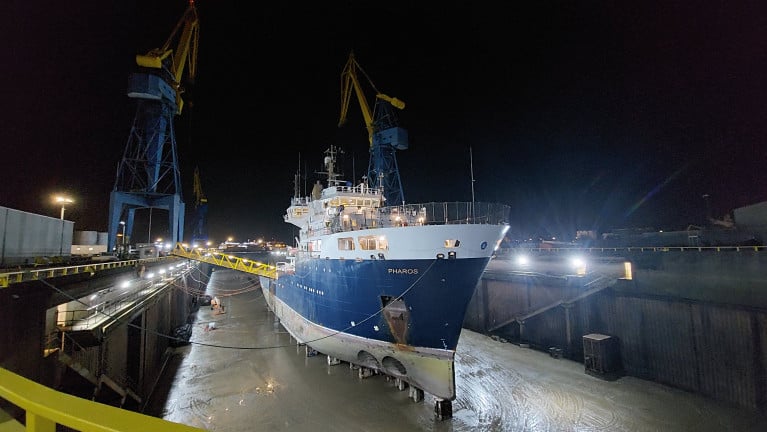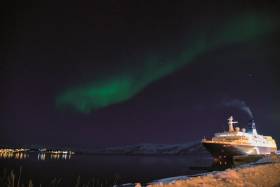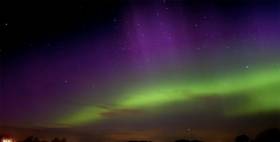Displaying items by tag: Northern Lights
Howth's Northern Lights Were Something Special
The weekend's almost freakish display of the Northern Lights were better seen in some places than others. Howth on its peninsula avoided the later thundery rain which affected other parts of the country, some with flooding. The HYC Photography Fellowship were busy, with the Talented Turveys' Conor Turvey - best known for ace helming on the Howth 17 Isobel - managing to get a quartet of images of such quality that the stars themselves are seen clearly as part of what are some very big pictures - in every sense.
 Howth's outer harbour is looking eastward, with the HYC Howth 17s and Squibs making up the bulk of the fleet lying to moorings. Photo: Conor Turvey
Howth's outer harbour is looking eastward, with the HYC Howth 17s and Squibs making up the bulk of the fleet lying to moorings. Photo: Conor Turvey
 The humble Starter's Hut on the East Pier fronted up the most colourful display. Photo: Conor Turvey
The humble Starter's Hut on the East Pier fronted up the most colourful display. Photo: Conor Turvey
 Howth Lighthouse - probably the most-photographed building on the Peninsula - had to share the stage with a rare display of cosmic glory. Photo: Conor Turvey
Howth Lighthouse - probably the most-photographed building on the Peninsula - had to share the stage with a rare display of cosmic glory. Photo: Conor Turvey
Northern Lighthouse Board's Aids to Navigation Tender Dry-Docks for 'Special Survey' at H&W Belfast Shipyard
Northern Lighthouse Board’s aids to navigation vessel NLV Pharos which operates in Scottish waters, is currently at Harland & Wolff's Belfast shipyard for a scheduled dry-docking which happens twice in a 5 year-period, writes Jehan Ashmore.
Commenting to Afloat, Mike Bullock, Chief Executive of the Northern Lighthouse Board said "this is NLV Pharos’ year 15 ‘Special Survey’ which means the ship is receiving a class survey and recertification. The maintenance work includes complete overhaul and bearing change of the main azimuth propulsion units and tunnel thrusters, crane overhaul and preservation and painting of the hull".
Pharos' primary role is to respond to wrecks and new navigational dangers, as the vessel supports the maintenance and refurbishment of NLB’s 200 plus lighthouses as well as conducting buoy operations.
To assist operations, Pharos is equipped with a helicopter pad, dynamic positioning (DP), a 30 tonne crane and a hydrographic survey suite.
The 2007 built NLV Pharos is homeported in Oban, west Scotland from where the vessel along with the smaller NLV Pole Star (see replacement story) works from this base in addition to serving in Isle of Man waters.
Technical operations are also carried out at Oban which provides maintenance workshops and facilities for the construction of buoys and beacons.
In addition to the Oban base, technicians are located in Inverness, Orkney and Shetland. As for the headquarters of NLB, they are located in Edinburgh with a staff of 80 personnel.
The NLB is one of three General Lighthouse Authorities (GLA's) as Trinity House is the authority for waters off England, Wales and Gibraltar. Whereas the Commissioners of Irish Lights is responsible for all waters off the coast of Ireland.
Whale-Watching Season Begins With St. Valentine's Cruise to 'Northern Lights' in Norway
#CruiseLiners - On this Valentine’s Day the yacht-like cruiseship Saga Pearl II is due to depart Portsmouth International Port (PIP) at 17.00 this afternoon to see the Northern Lights in Norway. It won’t just be guests on board hoping to see incredible sights.
According to PIP, a team from ORCA, a marine conservation charity based in the UK's second busiest ferryport, will also be joining the crew of the Saga Cruises ship on the 15 night holiday. It will be the first survey of 2018 for ORCA, one of eleven journeys they will be making from Portsmouth with Saga this year to learn more about marine mammals and habitats in which they live.
The cruise from the historic maritime city of Portsmouth explores Norway's coastal waters and heads into the Arctic Circle. Last year's cruises to the same area saw everything from humpback whales to harbour porpoises, and sperm whales to pilot whales.
ORCA has also just announced it is to partner with another cruise ship operator at Portsmouth. Noble Caledonia specialises in small cruise ship holidays accessing incredible natural habitats that larger vessels can’t visit. A “unique and innovative marriage” between the charity and Noble Caledonia is expected to expand a citizen’s science programme onboard the small luxury liners.
Tim Cochrane, Noble Caledonia Managing Director, said “I am delighted to be able to introduce this concept into our expedition tours and to be working with ORCA: I know that our guests will relish being part of this exciting initiative as part of their holiday with us such that they can take away even more than the lasting memories our holidays provide. The opportunity to join in with some of the scientific research being undertaken by our knowledgeable and experienced expedition team members, many of whom are experts in their own fields, will, I am sure, enhance guest experience on our expedition tours”.
Saga Pearl II is the smallest of the operator's fleet and as Afloat reported the intimate 449 passenger cruiseship has in recent years called to Warrenpoint, where there are plans to boost cruise tourism.
Northern Lights Shimmer Over Belfast & Lough Neagh
#Aurora - Skywatchers in Northern Ireland were treated to a spectacular light show last night (Monday 7 March) as a "lucky combination" of weather conditions made the aurora borealis visible across much of the country.
The video below, via Tam Mullen and the Belfast Telegraph, shows how the Northern Lights looked over Belfast and Lough Neagh.
Amazing Images Of Northern Lights Over Aran Islands
#Aurora - The Irish Independent has an amazing photo gallery of the midsummer Northern Lights over the Aran Islands earlier this week.
Setting up late on Monday night on Inis Óirr, local teacher Cormac Coyne captured the incredibly rare spectacle - for the location, far from the Arctic Circle, as much as the time of year - with a DSLR camera mounted on a tripod to take the long exposures necessary for shooting at night with very little light.
And the results are astounding, as you can see for yourselves HERE.
































































